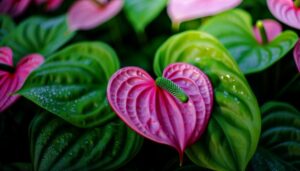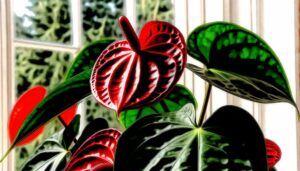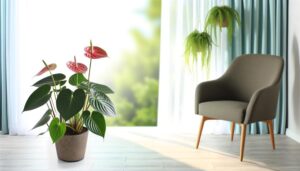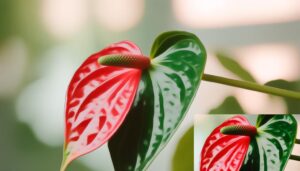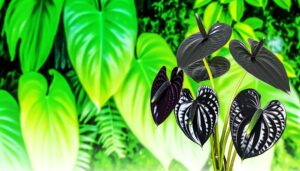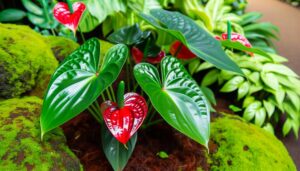Caring for the Rare Black Anthurium
Proper care for the rare Black Anthurium involves meticulous attention to its ecological needs. It thrives in bright, indirect light, requiring 2000 to 2500 foot-candles for best photosynthesis.
The preferred temperature range is 65-80°F, ensuring metabolic efficiency and preventing stress. Humidity levels should be maintained between 70% and 80%, using humidifiers if necessary.
The soil must be well-draining and aerated, enriched with organic matter and supplemented with perlite or orchid bark. Apply a balanced 20-20-20 NPK fertilizer bi-monthly, and monitor pH levels, maintaining a range of 5.5 to 6.
Regular pest inspections and biological controls are essential. Discover the full intricacies of Black Anthurium care.
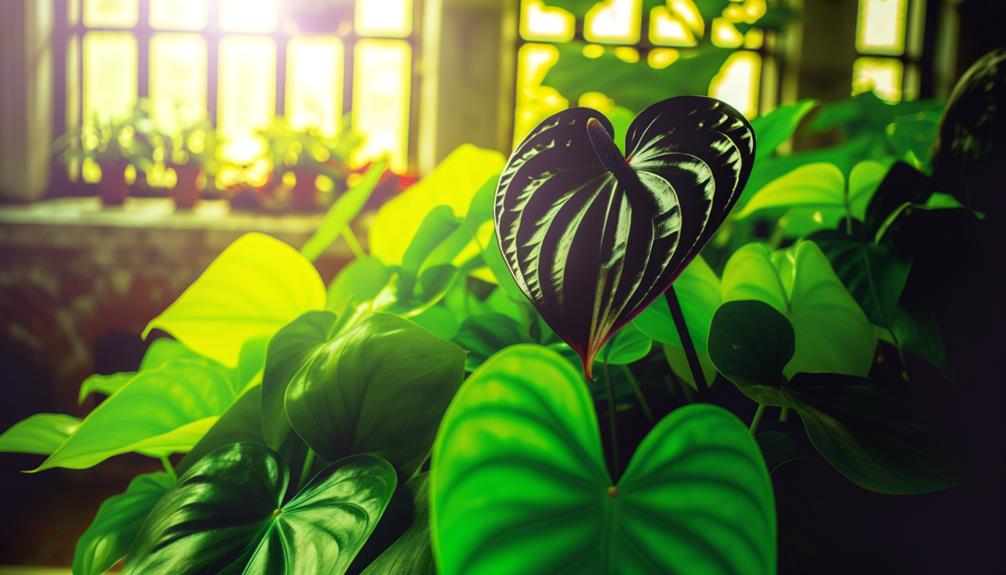
Key Takeaways
- Provide bright, indirect light with 2000-2500 foot-candles for optimal photosynthesis.
- Maintain temperature between 65-80°F (18-27°C) for healthy growth and flowering.
- Ensure humidity levels of 70-80% to support plant health.
- Use well-draining soil rich in organic matter, supplemented with perlite or orchid bark.
- Apply balanced, water-soluble fertilizer (20-20-20 NPK) bi-monthly for nutrient support.
Light Requirements
Although the rare black anthurium can tolerate low light conditions, it thrives best under bright, indirect light to promote growth and vibrant foliage.
This Anthurium species requires approximately 2000 to 2500 foot-candles of light for best photosynthetic activity. Direct sunlight may cause photoinhibition and chlorophyll degradation, leading to foliar damage. Positioning the plant near an east-facing window or using sheer curtains can mitigate excessive light intensity.
Photoperiod stability, maintaining around 12-14 hours of light daily, aligns with the plant's native tropical habitat, promoting robust growth and anthocyanin production. Employing full-spectrum grow lights can supplement natural light, ensuring uniform light distribution.
Monitoring light levels with a quantum light meter can further enhance conditions, enhancing the plant's physiological performance.
Ideal Temperature
The best temperature range for the black Anthurium (Anthurium andraeanum) is between 65-80°F (18-27°C), which supports its growth and flowering processes.
It is essential to avoid temperature extremes, as conditions below 55°F (13°C) or above 90°F (32°C) can lead to physiological stress and hinder plant development.
Maintaining consistent temperatures within this range will help the Anthurium thrive in its environment.
Optimal Temperature Range
Maintaining a temperature range between 70°F and 85°F (21°C to 29°C) is necessary for the best growth of the rare Black Anthurium. Within this range, metabolic processes such as photosynthesis and respiration are maximized, promoting vigorous growth and robust health.
This thermophilic species thrives in consistently warm conditions, which mimic its native tropical habitats. Deviations from these temperatures can disrupt enzymatic activities, leading to reduced nutrient uptake and stunted growth.
Additionally, maintaining this ideal temperature range facilitates proper transpiration rates, ensuring adequate hydration and nutrient transport throughout the plant. Monitoring and regulating ambient temperatures is essential for avoiding thermal stress, which can compromise cellular integrity and overall vitality.
Proper temperature control is thus a cornerstone of effective Black Anthurium care.
Avoiding Temperature Extremes
Exposure to temperature extremes, whether excessively high or low, can severely impair the physiological functions of the Black Anthurium, leading to cellular damage and metabolic imbalances.
The ideal temperature range for maintaining peak growth and health is between 18°C to 25°C. Temperatures below 15°C can induce chilling injury, manifesting as chlorosis and necrosis of the leaves, while temperatures above 30°C can cause heat stress, resulting in wilting and reduced photosynthetic efficiency.
To mitigate such risks, it is imperative to utilize environmental controls like thermostats and humidifiers. Regular monitoring with precise thermometers can ensure the microclimate remains within the desired parameters, thereby safeguarding the plant's intricate physiological processes from deleterious thermal fluctuations.
Humidity Levels
Maintaining ideal humidity levels is essential for the health of the rare Black Anthurium, with an ideal range between 70% and 80%. Indoor environments often necessitate the use of humidifiers or pebble trays to maintain these conditions.
Indications of insufficient humidity include browning leaf tips and reduced plant vigor, which warrant immediate corrective measures.
Ideal Humidity Range
To thrive at its best, the black anthurium requires a consistent humidity level between 60% and 80%, which mimics its native tropical environment. This specific humidity range is essential for maintaining the plant's physiological processes, such as transpiration and nutrient uptake.
Inadequate humidity can lead to desiccation of the leaves, reducing photosynthetic efficiency and causing less-than-ideal growth. Conversely, excessive humidity may foster pathogen proliferation, particularly fungal infections.
Monitoring ambient humidity with a hygrometer enables precise adjustments to maintain these ideal conditions. The plant's stomatal function, critical for gas exchange, is highly sensitive to humidity fluctuations, underscoring the significance of consistency.
Thus, careful observation and control of humidity levels are indispensable for the health and vigor of the black anthurium.
Maintaining Humidity Indoors
Achieving the finest indoor humidity levels for black anthurium cultivation necessitates the strategic use of humidifiers, pebble trays, and regular misting to replicate its native tropical conditions.
Humidifiers are particularly effective, maintaining a consistent relative humidity of 60-80%, essential for utmost physiological processes.
Pebble trays, filled with water, provide localized humidity through evaporation, benefitting the microenvironment around the plant.
Regular misting with distilled water adds immediate moisture but should be monitored to prevent fungal growth.
Integrating hygrometers allows for precise humidity measurements, ensuring the environment remains within the ideal range.
Signs of Low Humidity
Identifying signs of low humidity in black anthuriums is essential for preventing physiological stress and ensuring the healthiest plant condition. Observable symptoms of low humidity include leaf curling, brown leaf tips, and stunted growth.
The foliage may exhibit increased susceptibility to pathogens due to compromised cuticular integrity. Additionally, the plant's transpiration rate may elevate, leading to rapid moisture loss and subsequent desiccation. Another indicator is the development of necrotic spots on foliage, often resulting from impaired cellular function.
Monitoring relative humidity with a hygrometer, aiming for levels between 70-80%, is optimal. Employing humidifiers or pebble trays can mitigate low humidity effects.
Regularly inspecting plants for these signs can preempt severe damage and promote the best growth conditions.
Watering Tips
Proper hydration of the rare black Anthurium involves maintaining a delicate balance between moisture levels and preventing waterlogging. This can be achieved by ensuring the soil is consistently damp but not saturated. This species thrives in a humid microenvironment, necessitating regular monitoring of soil moisture content. Utilize a moisture meter to ascertain the ideal hydration level, typically when the top inch of soil begins to dry.
Overwatering can lead to root rot caused by anaerobic soil conditions, while under-watering may induce wilting and stress. Employ tepid, dechlorinated water to avoid thermal shock and chemical damage to the roots. Additionally, watering should be performed in the morning to facilitate efficient evaporation and reduce fungal pathogen proliferation.
Soil and Fertilizer
The best soil mixture for the rare black Anthurium is a well-draining, aerated substrate, rich in organic matter and supplemented with perlite or orchid bark to enhance root oxygenation. This guarantees a balance between moisture retention and drainage, essential for preventing root rot.
Nutrient-wise, the black Anthurium thrives with a balanced, water-soluble fertilizer, ideally a 20-20-20 NPK ratio, applied bi-monthly during the growing season. Avoid over-fertilization as excess nitrogen can lead to foliage burn and reduced flowering. Incorporating slow-release fertilizers can provide a sustained nutrient supply.
Monitoring the pH is also crucial, as Anthuriums prefer slightly acidic to neutral soils, with an ideal pH range of 5.5 to 6.5, ensuring nutrient availability and root health.
Pest Control
Effectively managing pests for the rare black Anthurium requires a thorough understanding of the specific threats posed by common arthropod pests such as spider mites, aphids, and mealybugs. An integrated pest management (IPM) approach is crucial for maintaining plant health and aesthetics.
Key strategies include:
- Regular Monitoring: Inspect plants weekly for early detection of pest infestations.
- Biological Control: Introduce natural predators like ladybugs and predatory mites to control pest populations.
- Chemical Treatments: Use insecticidal soaps and neem oil as targeted treatments, ensuring adherence to application guidelines to minimize phytotoxicity.
- Cultural Practices: Maintain ideal humidity and sanitation practices to create an unfavorable environment for pests.
Implementing these measures will enhance the vitality and longevity of the rare black Anthurium.
Conclusion
To sum up, the rare black anthurium requires precise environmental conditions, including specific light, temperature, humidity, watering, soil, and pest control measures, to thrive.
Importantly, keeping humidity levels between 70-80% can greatly improve its growth.
This particular anthurium species, with its strikingly unique black spathes, is a testament to the intricate beauty found in botanical diversity.
Proper care, based on scientific understanding, guarantees the best health and aesthetic appeal of this rare and enchanting plant.

